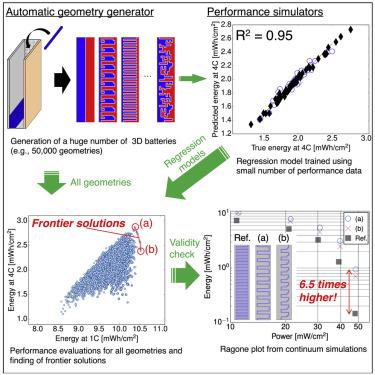Cell Reports Physical Science ( IF 8.9 ) Pub Date : 2021-07-21 , DOI: 10.1016/j.xcrp.2021.100504 Kaito Miyamoto 1, 2 , Scott Broderick 1 , Krishna Rajan 1

|
Three-dimensional (3D) microbatteries are promising candidates as power sources for internet-of-things (IoT) devices. To accelerate the design of 3D microbatteries, we develop and apply a battery-optimization system that consists of an automatic geometry generator coupled with an efficient machine-learning (ML) platform. The input into the analysis is a small amount of performance data from continuum simulations. Because ML-based simulators evaluate the battery performance quickly at an accuracy comparable with that of continuum simulations, it is possible to discover high-performance batteries from many candidate geometries. We successfully design a set of microbatteries having greater energy than the simplest interdigitated-plate configuration, without reducing the power. The results show that the optimal geometry changes with the applied current. One geometry displays 1.4 times greater energy at 3.16 mA/cm2 and the other shows 6.5 times greater energy at 15.8 mA/cm2 compared with the reference geometry. The results exemplify the benefit of our method.
中文翻译:

通过自动几何生成器和基于机器学习的性能模拟器进行三维微电池设计
三维 (3D) 微电池是作为物联网 (IoT) 设备电源的有前途的候选者。为了加速 3D 微电池的设计,我们开发并应用了一个电池优化系统,该系统由一个自动几何生成器和一个高效的机器学习 (ML) 平台组成。分析的输入是来自连续模拟的少量性能数据。由于基于 ML 的模拟器以与连续模拟相当的精度快速评估电池性能,因此可以从许多候选几何结构中发现高性能电池。我们成功地设计了一组比最简单的叉指板配置具有更大能量的微电池,而不会降低功率。结果表明,最佳几何形状随施加的电流而变化。一种几何形状在 3.16 mA/cm 时显示出 1.4 倍的能量与参考几何形状相比,图2和另一个显示 15.8 mA/cm 2 时的能量高 6.5 倍。结果证明了我们方法的好处。



























 京公网安备 11010802027423号
京公网安备 11010802027423号